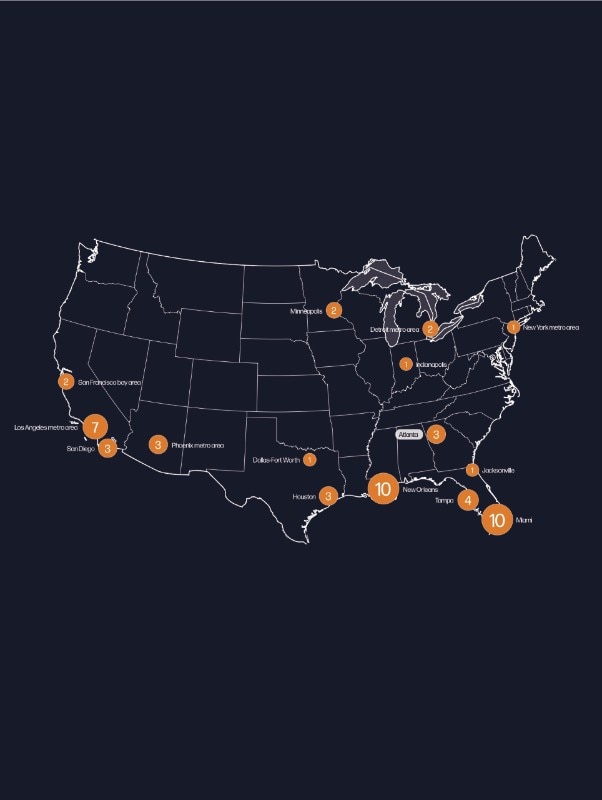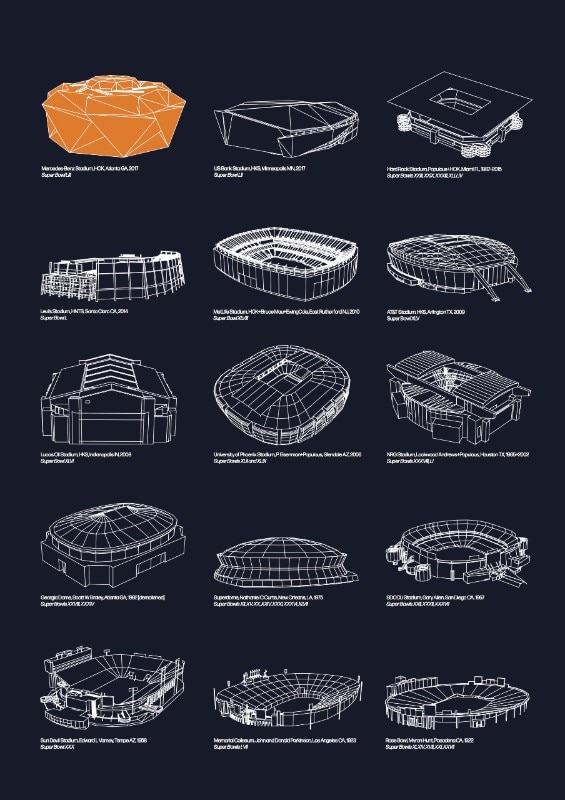Each year more than 110 million people gather in crowded bars or sit on comfortable sofas to enjoy what is by far the most-watched broadcast event in America ‒ the Super Bowl. Across the US, major cities compete to host the NFL final and in 2019 Atlanta is home of Super Bowl LIII. This time the Big Game got even bigger, launching the commemorations for the 100th season of the National Football League. The 53rd edition is not the first one for the capital of Georgia though. People still remember the year 2000’s competition due to the unusual ice storms that froze the city and a spectacular tackle during the last few seconds of the game ‒ the One Yard Short. Back then, the Super Bowl used to be a one-day show about the Sunday’s final with just a few side events. Over the years, it has evolved into a much larger and more complex ten-day urban festival.

During the weeks preceding the game, the host city typically transforms its appearance and disrupts its everyday dynamics. An ephemeral “city” gets built within the permanent urban fabric, with temporary structures popping up both in the area surrounding the stadium and in the downtown streets. As expected, broadcast booths then accommodate a myriad of networks and provisional infrastructures support the demanding operations for the Super Bowl.
Global attention and the significant influx of fans into town also present a fertile ground for collateral entertaining activities. Exhibitions and music performances are in fact the main attractions during the nine days leading up to the competition. When the largest football-themed developments are the NFL Tailgate, Super Bowl Live and SB Experience, the most elaborate construction for a concert experience revolves around the DirecTV Super Saturday Night, a live show that in the past has featured artists such as Bruno Mars, Jay-Z and Beyoncé, Pharrell Williams and the Red Hot Chili Peppers.

Over the years both the size and complexity of this concert venue have grown exponentially, reflecting the evolving trend of the Super Bowl. It started off in 2010 as an outdoor celebrity football game on the beach of Miami that culminated with a small musical performance. Since then the “beach” was trucked to various other cities. In 2014 the operation involved one million pounds of sand brought in through a snowstorm in New York City. Beach Bowl during the day, the two-level tent space was converted within six hours into a nightclub for the evening. In Phoenix the programme expanded into a 3-day music and food festival that took over a 42-acre field to accommodate 4 stages.
As the programme expanded so did the ambitions of the venue, forcing to change up the design approach from purely reconfiguring a temporary steel tent. For the 2016 Super Bowl in San Francisco, a 100-year-old former warship factory was converted into a three-level, dual-stage venue that weaved its steel and timber structure into the existing framework. A similar approach was employed for Minneapolis, where last year an old armory was renovated to host a concert series on the SB weekend. The place now operates as a permanent cultural venue. This time in Atlanta the DirecTV event took place in the Atlantic Station neighbourhood, a couple of miles from the Mercedes-Benz Stadium ‒ the innovative retractable-roof arena where the February 3rd final was played. The centrepiece is a three-level hybrid and custom steel structure with a capacity of 10,000 people and over 100,000 square-feet large, half the size of a typical indoor concert venue such as Madison Square Garden in New York or the Pala Alpitour in Turin. The venue was conceptualised by executive producer Jack Murphy, the creative mind of large-scale Super Bowl shows for almost three decades.Behind the scenes of this “nomadic” entertainment experience, there is a year-long rigorous design and managing process. Tight contextual constraints and time pressure force the phases of the design and construction to merge into a chain of immediate decisions, often going straight from the 3D model into the fabricator’s hands for instant production. Reusable materials as well as the trusses, steel and timber are trucked in from Las Vegas. Yet the majority of the labour and resources are assembled locally to build this massive structure over a period of just 45 days. By combining experimental spatial explorations with cutting-edge technological solutions, the project expands beyond musical performances, incorporating augmented and virtual reality as well as interactive video walls and hologram displays.
People still remember the year 2000’s competition. Back then, the Super Bowl used to be a one-day show about the Sunday’s final with just a few side events. Over the years, it has evolved into a much larger and more complex ten-day urban festival.
In Atlanta a sequential setup has been designed that explores a diversified user engagement, from both a visual and acoustic point of view. The exterior of the structure is animated with double-sided projection mapping that unfolds over the main entrance, pinpointing the event as a temporary landmark in the city. But if on the one hand the Super Bowl is a ten-day spectacle for the more than one million visitors that take over Atlanta, on the other hand it is a ten-year opportunity for its residents. As for any city hosting such an impactful event, the Big Game is in fact a rare occasion for boosting economic development, improving transport infrastructures, and showing off to fellow Americans and to the whole world the cultural values of the local community.
To that end, the Atlanta Super Bowl LIII Host Committee (the planning team that acts as the liaison between the NFL, the City of Atlanta and the local community) last year launched an ambitious initiative to leverage the Super Bowl for a long-lasting positive repercussion on the city. Named Legacy 53, the programme is built on five pillars: sustainability, business connect, a capital improvement project, youth engagement, and civil rights and social justice.
The sustainability pillar is implemented through 11 urban forestry projects for planting over 20,000 trees, creating pollinator habitat and building community gardens in several neighbourhoods. The business connect programme takes advantage of the economic impact of the Super Bowl to elevate over 200 local minority-, women- or LGBT-owned businesses for contracting opportunities. The Capital Improvement Project has instead resulted in a two-million-dollar renovation of the John F. Kennedy Park, near the stadium. The Youth Engagement programme then helps address food insecurity, physical inactivity and academic achievement in metro Atlanta’s schools.
Finally, Super Bowl LIII will leave a fresh physical trace in the urban context. Through the Off the Wall project, 11 American artists were selected to install 30 murals around downtown that speak about the city’s civil rights and social justice issues. The artworks were inspired by months of community conversations which brought out unheard stories that needed to be told, as stated by arts group WonderRoot. For viewers walking by the murals, the experience is also digitally enhanced by hearing the mural’s narrative. This public art project will ultimately act as a constant reminder for Atlanta’s citizens and visitors to foster a more socially responsible community in the years to come.
Text, research, infographics Stefano Andreani, Joanna-Maria Helinurm.

